Something is said to be symmetrical when the left and right halves match each other as in a mirror image on either side of a central line. Nature is replete with this kind of symmetry. Our tabby cat, Nina, in the photo above, shows off her wonderfully symmetrical structure and facial markings.
For most animal species the body shape is bilaterally structured, akin to mirror symmetry. Although there are animal species, such as jelly fish, corals and anemone, whose structural symmetry is radial rather than bilateral, they are in a minority. The human body too is bilaterally structured – although the internal organs are not necessarily symmetrically distributed.
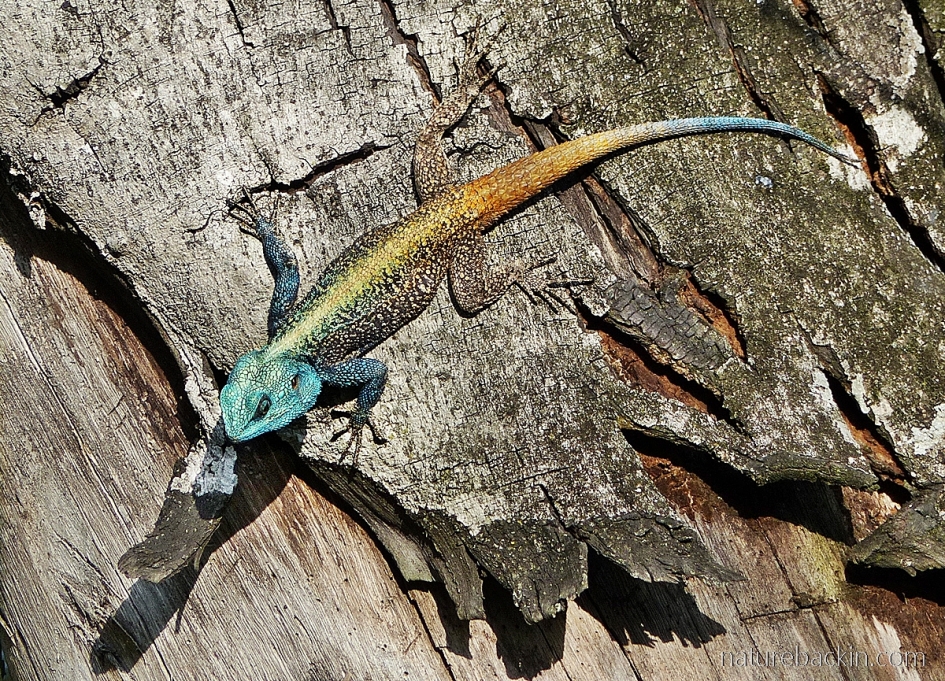
This southern tree agama (in our garden) displays its bilateral symmetry on either side of an imaginary central line. Although to any observer the right side and the left side are pretty much symmetrical (although not as perfectly so as in a computer-created drawing for instance) it is interesting that in certain aspects animals may be functionally asymmetric. For example, in humans at least, most individuals are right- or left-handed, and the hemispheres of the brain have functional asymmetry.
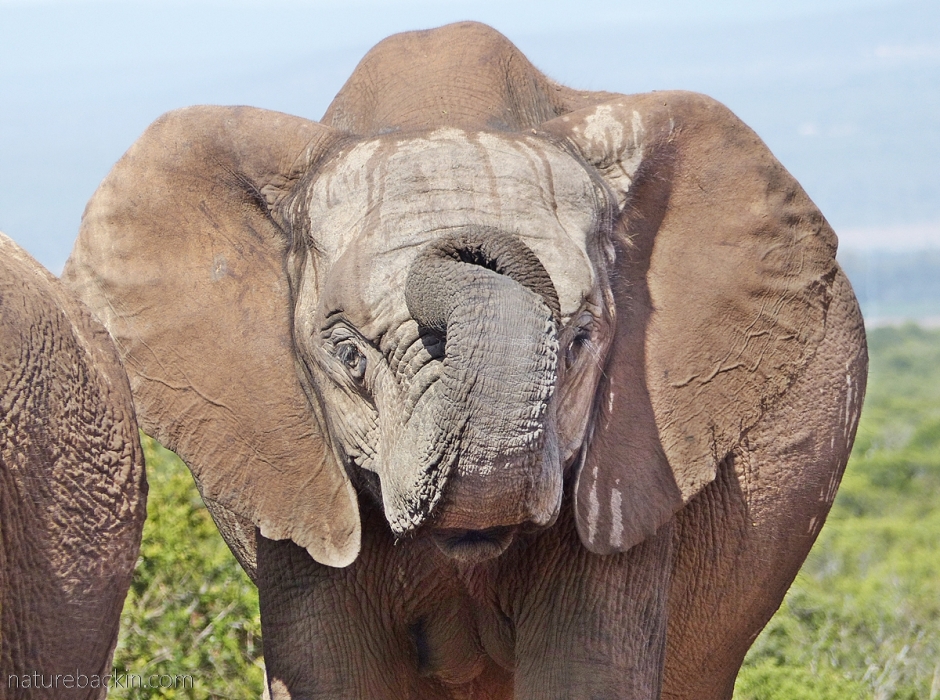
This elephant (at Addo Elephant Nation Park) shows off its symmetrical structure with the trunk and mouth on the central bisecting line. Interestingly, the majority of female elephants at the Addo park lack tusks.
This general tusklessness is thought to have resulted from the long history of killing of elephants for their tusks. In isolated populations this selective killing resulted in the existence of a higher than normal percentage of tuskless elephants among survivors. With only a small population left before elephants became protected at Addo, the unnatural selection resulted in a genetic preponderance for tuskless elephants. A similar scenario has been observed at Gorongoza National Park in Mozambique. For fascinating background information on this phenomenon see https://www.earthdate.org/tuskless-elephants
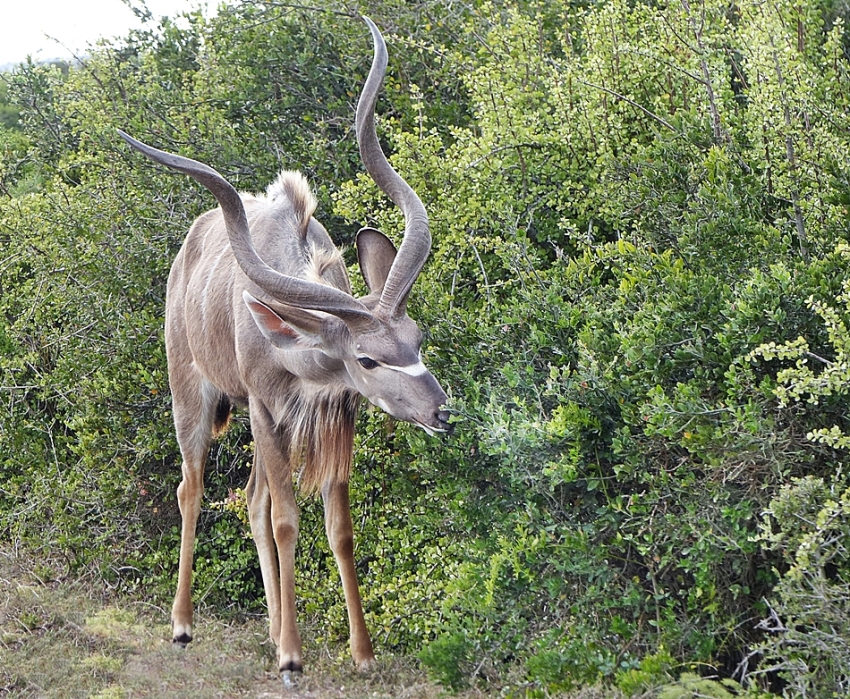
One of the most spectacular displays of bilateral symmetry can be seen in the long and elegant horns of male kudu antelope. This one is browsing near the roadside at Addo Elephant National Park.
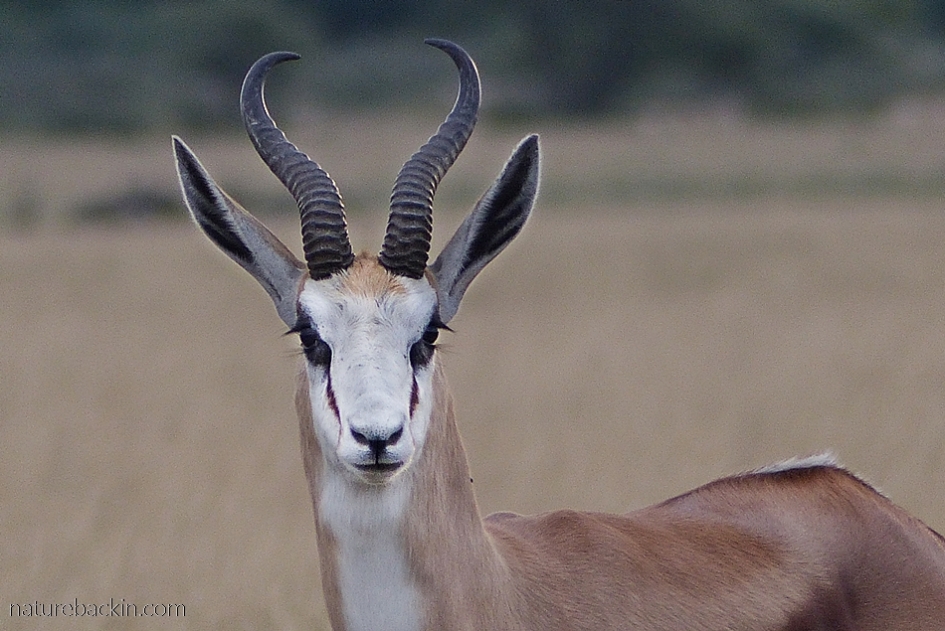
Iconic in South Africa is the Springbok. Photographed in the Central Kalahari Game Reserve in Botswana, this springbok ram displays his symmetrical horns and facial markings. Springboks once roamed South Africa in vast migratory herds especially in the Highveld and Karoo regions. Sadly though, the last great migration in the Karoo took place at the end of the 1800s. Farming, fencing and hunting were major factors in the dramatic decline in the wild herds of springbok. Nevertheless, to this day trophy hunters include springboks in their list of targets.

One of the stranger -looking antelopes is the red hartebeest. I photographed this one at the Mountain Zebra National Park. Both male and females hartebeests have horns, with the males generally having heavier horns than the females do.
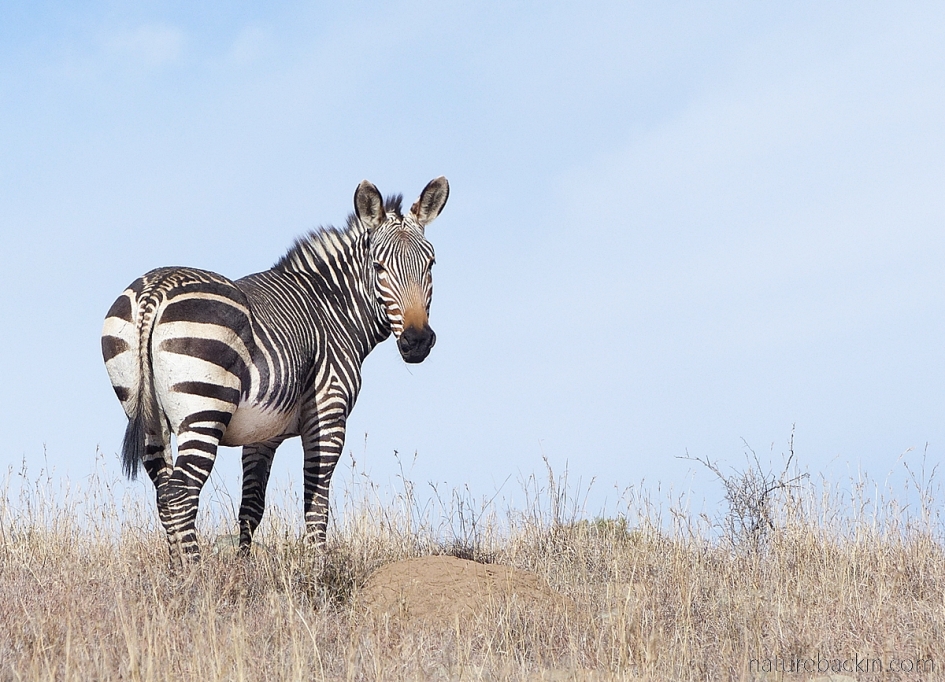
This Cape mountain zebra (at the Mountain Zebra National Park) shows how the complex pattern of stripes tends towards being symmetrical, at least on the rump and forehead. Each zebra has a unique stripe pattern with no two zebras having identical stripes.

Like most creatures, butterflies are structured with bilateral symmetry, but also the patterning on their wings is almost perfectly symmetrical, as can be seen on the open wings of this garden inspector butterfly, which I photographed as it basked in winter sunshine in our garden.

These foam grasshoppers show their obvious symmetry. As they approach through the grass they resemble an advancing army.

Wings spread to dry after a bout of fishing, this white-breasted cormorant displays the almost perfect symmetry of its wings. Obviously symmetry in birds is essential for flying efficiently, as it is for walking and running in mammals and other animals.
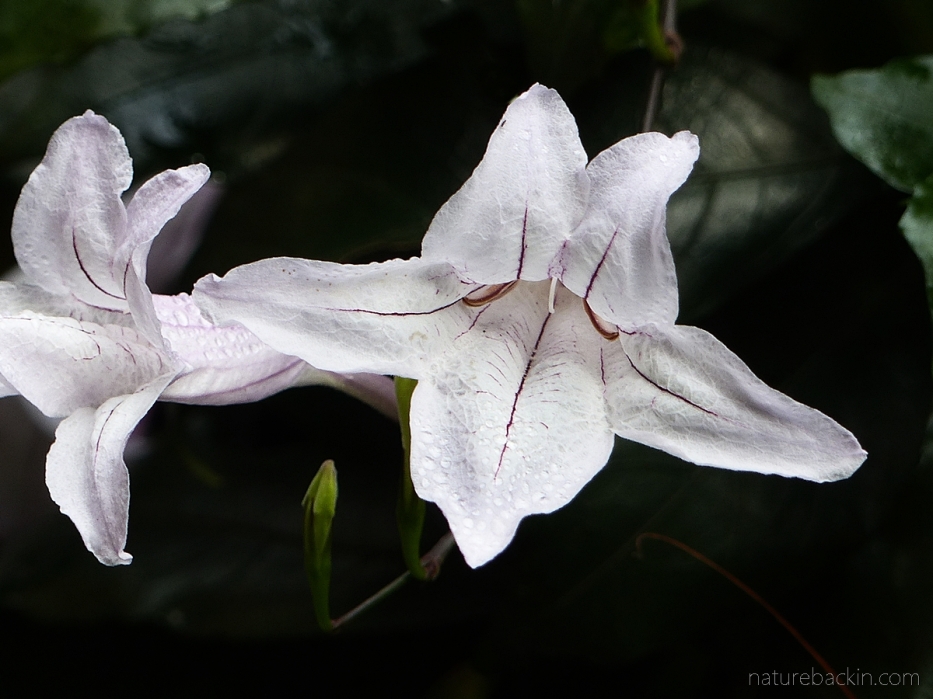
It is not only animals that are structured bilaterally as evidenced by this flower of a Mackaya bella. The shape and stripes help guide pollinating insects into the throat of the flower. Additional guiding patterns on these flowers that insects can detect can only be seen by the human eye under ultra-violet light.
Flowers are the fertilization point for plants so they have evolved to attract pollinators, with some flowers adapted to attracting specific species of pollinators. Flowers that display bilateral symmetry are more likely to have specialised signals for specific pollinators than flowers with radial symmetry.
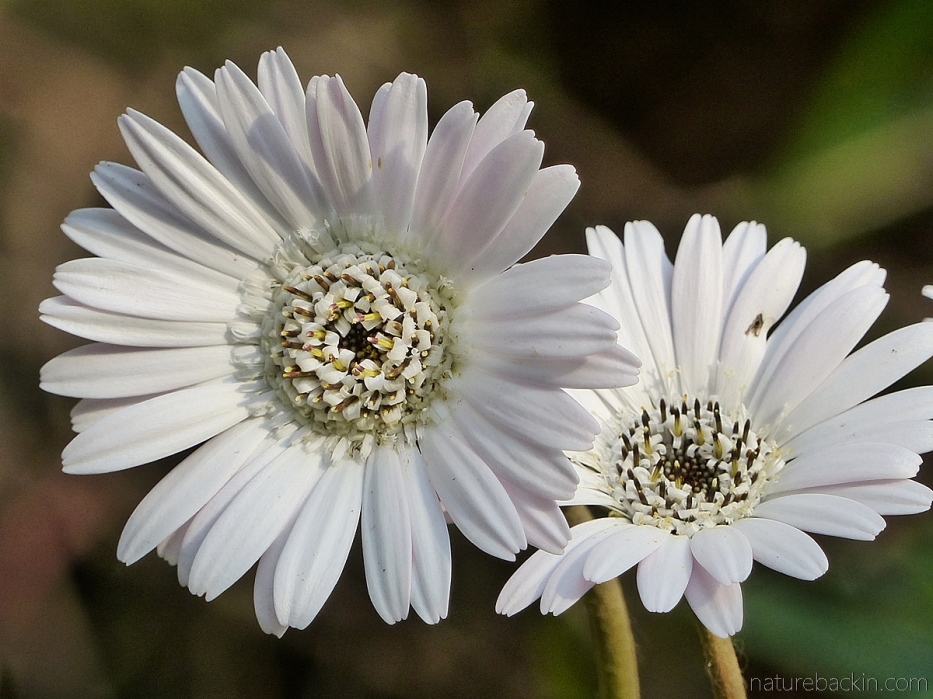
The structure of these gerbera flowers displays radial symmetry – the petals are arranged symmetrically around a central point. More flowers display radial symmetry than bilateral symmetry. Bilateral symmetry in flowers evolved in relation to attracting specific pollinators and developed from earlier radially symmetrical forms (for more see Symmetry in Organismal Biology).

These gazanias (probably hybrids, which I photographed in the Western Cape), are a spectacular example of flowers with radial symmetry.

A more complex variant of radial symmetry is displayed by this wild iris (Dietes grandiflora).
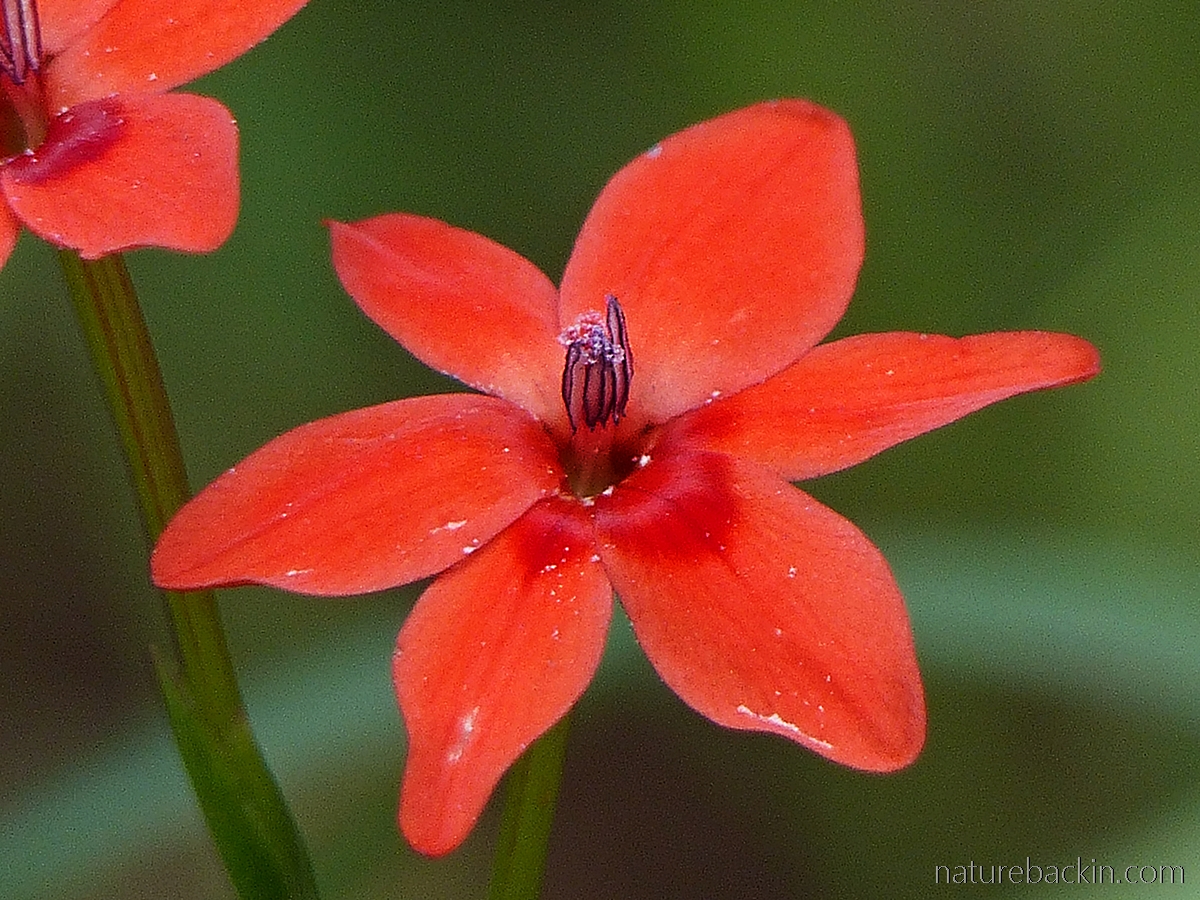
Also displaying radial symmetry are the petals of this Freesia laxa.
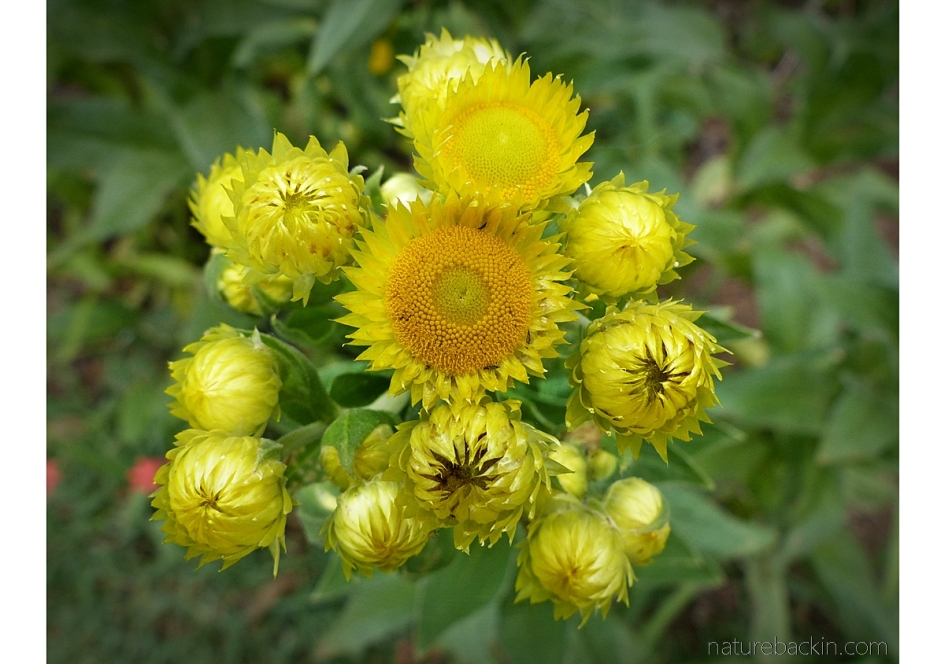
The buds and the open flowers of the yellow everlasting (Helichrysum cooperi) also exhibit radial symmetry. In our garden these attractive grassland plants self-seed to reliably produce a new crop of plants that flower during the summer months.
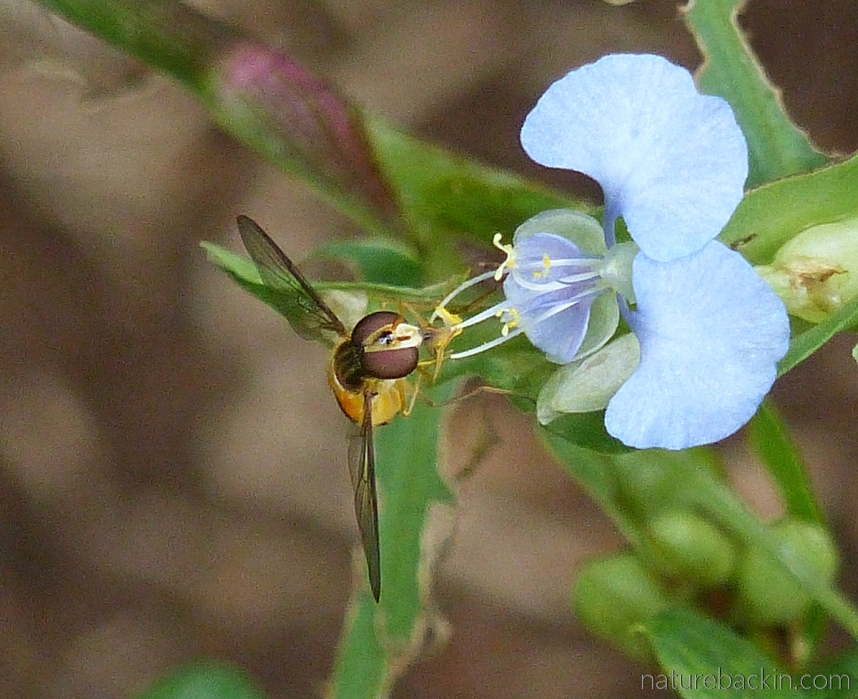
In contrast, here is the bilaterally symmetrical flower of the tropical spiderwort (Commelina benghalensis) attracting a hoverfly, which of course also exhibits bilateral symmetry.

This rather striking flower decorated with rain drops also exhibits bilateral symmetry. I have no idea of the identity of this exotic plant that cropped up in our garden at one time but has since disappeared.

Leaves of plants are also structured with bilateral symmetry, even though the symmetry may not be exact. These are leaves of the wild mulberry (Trimeria grandifolia ), photographed in our garden.

Prominently symmetrical in an unusual set of matching pairs and with each leaf being bilaterally symmetrical too, are freshly sprouted leaves of the toad tree (Tabernaemontana elegans), which is deciduous in our garden.

The fruit of the toad tree (Tabernaemontana elegans) appears in symmetrical pairs. These were the first fruits on this young tree, which we planted only last year. I hoped to see the fruits grow and eventually bear seed, but this was not to be. Something ate the undeveloped fruit the day after this photo was taken!

And I end off with a photo of an African buffalo at Addo Elephant National Park, displaying not only the bilateral symmetry of the curved horns, but also the symmetry of four muddy ‘boots’. The ‘boots’ match the glistening mud on the forehead and crown as the buffalo walks away from a waterhole after an early morning drink.
Posted by Carol









January 28, 2021 at 12:41 am
I thought of you….. https://vimeo.com/9953368
LikeLiked by 1 person
January 28, 2021 at 6:31 pm
Wow this is beautiful – thank you. Doing a post on spirals is still on my to do list as is reading more about the numbers!
LikeLike
November 23, 2020 at 7:43 pm
I was thinking fascinating and informative to describe this post, noticing that I’m echoing Eliza’s comment.
LikeLike
November 23, 2020 at 8:34 pm
Thanks Gunta – there is something rather calming in such symmetry.
LikeLiked by 1 person
November 23, 2020 at 11:44 pm
Indeed! A mandala might be seen as an intense/extreme example of symmetry.
LikeLiked by 1 person
November 25, 2020 at 9:13 pm
Yes that is true!
LikeLike
November 16, 2020 at 10:43 am
Another astounding post. Thank you Carol.
LikeLiked by 1 person
November 16, 2020 at 8:30 pm
Thanks very much Mariss.
LikeLiked by 1 person
November 15, 2020 at 11:27 am
Great series on patterns and other structures! Reading about this, I found myself staring at a cockroach too hard realising it has bilateral symmetry. :p
LikeLiked by 1 person
November 15, 2020 at 12:52 pm
Thanks Srishti, and I know what you mean about looking so hard 😊 How wondrous to find yourself acknowledging the bilateral symmetry of a humble cockroach!
LikeLike
November 15, 2020 at 1:10 pm
Exactly! Keep writing 🙂
LikeLiked by 1 person
November 15, 2020 at 1:13 pm
Thanks so much 😊
LikeLike
November 15, 2020 at 11:23 am
Beautiful nature
LikeLiked by 1 person
November 15, 2020 at 12:49 pm
Thanks – lots of beauty out there even in the ‘simplest’ of things. (When I think about it its quite odd that daisies are regarded as being ‘simple’!)
LikeLiked by 1 person
November 15, 2020 at 3:54 pm
Indeed!
LikeLiked by 1 person
November 15, 2020 at 4:33 am
A lovely and informative post as always. The antelopes are wonderful and the grasshopper photo was well worth the effort. I’m not sure I feel very symmetrical these days, but I’m too scared to check in a mirror.
LikeLiked by 1 person
November 15, 2020 at 11:55 am
Thanks Graham.
Well you know, these days they don’t make mirrors like they used to …
LikeLiked by 1 person
November 16, 2020 at 3:12 am
I keep thinking I’m in a funhouse.
LikeLiked by 1 person
November 16, 2020 at 8:30 pm
😊
LikeLike
November 15, 2020 at 3:08 am
I really am enjoying this post-series of yours very much, Carol, both for the interesting reading and amazing photographs!
LikeLiked by 1 person
November 15, 2020 at 11:54 am
Thanks so much – as I am reading about patterning I am trying to catch up with some mathematics. Sjoe!
LikeLiked by 1 person
November 15, 2020 at 1:47 pm
With Joubert now in the final throes of Grade 5 I have a similar need, but different motivation, for rejuvenating my math knowledge… 😀
LikeLiked by 1 person
November 15, 2020 at 2:33 pm
And good luck with that – both to you and Joubert!
LikeLiked by 1 person
November 14, 2020 at 11:32 am
I enjoyed this blog, Carol, especially Nina’s portrait! Just wondering if the unidentified flower could be some sort of baleria?
LikeLiked by 1 person
November 14, 2020 at 3:29 pm
Thanks Christine. Nina is just so special!
Eliza (see her comment) has suggested that the flower is a Browallia. I have looked it up and it seems to be the most likely candidate.
LikeLike
November 14, 2020 at 11:20 am
Interesting and informative as always, Carol. Thank you. I never knew there were tuskless elephants – I thought evolution took much longer time than this. Amazingly beautiful shots – as always, and the Springbok and Kudu are exquisite animals. I must agree with some others here – those grasshoppers are spectacular – I am sure they have been used as models for some sci fi movies already.
LikeLiked by 1 person
November 14, 2020 at 3:27 pm
Thank you Leya. I suppose the processes of (un)natural selection are escalated when a population is down to such a small number of animals. It is interesting and rather sobering too.
The springbok and kudu are exquisite and I never tire of seeing our lovely antelopes.
I am sure that sci fi movie designers draw inspiration from the insect world!
LikeLike
November 14, 2020 at 10:07 pm
You are always highlighting my days – thank you!
LikeLiked by 1 person
November 15, 2020 at 11:51 am
Thanks so much Leya 😊
LikeLike
November 15, 2020 at 9:03 pm
♥
LikeLiked by 1 person
November 14, 2020 at 10:14 am
Wonderful photos to perfectly illustrate symmetry in nature, and I have been inspired to look more closely at symmetry in all animals and plants that I come across in the future. Nina is magnificent! What a beauty! I was really impressed by the photo of the Addo elephant and was not aware that they are tuskless. It was interesting to read up about that form of selection. Thanks for the link you provided on the unnatural selection. I also love the photo of the grasshoppers. What a great photo! A lovely and interesting post!
LikeLiked by 1 person
November 14, 2020 at 3:24 pm
It is interesting that once one starts to think about something like symmetry it can become a bit of filter.
Indeed we also think that Nina is magnificent so thank you 😊 She was found abandoned and nearly dead when she was less than a week old. We managed to hand rear her and since kittenhood she has been a powerful presence in our lives. She is now nearly ten years old.
I also found the tuskless elephants interesting. Those grasshoppers have an amazing power for such tiny creatures!
LikeLike
November 14, 2020 at 9:35 am
Fantastic post, Carol! Thanks! We are living in such an interesting and beautiful world. There are so much to explore…Wish I could have much more time…
LikeLiked by 1 person
November 14, 2020 at 3:18 pm
Thanks Simone. That is so true – interesting, beautiful and so much to find out about and learn!
I hope you are okay where you are. I am sorry the pandemic is surging in Europe. Here in SA we have had a bit of a lull and drop in active cases, but our number of cases is starting to rise again, which is of course a tremendous worry.
LikeLike
November 15, 2020 at 7:27 am
Thanks Carol, I’m fine. The situation in Germany is not quite as bad as in other European countries like Austria, Spain or Italy. But the number of cases is very high and worrying. Germany is the second oldest country after Japan, so there is great concern about high death rates in intensive care units. Stay healthy!
LikeLiked by 1 person
November 15, 2020 at 12:47 pm
Glad to hear you are okay, Simone. From where I sit it seems that Germany has been managing the pandemic pretty well, so it has been disheartening to see numbers rising there too, even though the situation is not as bad as in some other European countries. I did not know that about such a high percentage of the population being elderly. Extremely worrying and distressing times. Take care and I hope you stay healthy too, thanks.
LikeLiked by 1 person
November 14, 2020 at 5:41 am
As ever, fascinating stuff. The article about tuskless elephants, and its information about the continuing fear of humans that some animals have was interesting too. I’d always thought evolution was almost unobservably slow. Lovely pictures, as ever. You must have both patience and a great camera!
LikeLiked by 2 people
November 14, 2020 at 3:14 pm
I am glad you had the time to read that article as I also found it very interesting. I have seen a few populations of elephants (not in SA) that are terrified of humans and it unnerving to say the least to see how they frantically flee even when quite a distance away. Definitely learned behaviour.
These photos were collected over quite a long period of time.
LikeLiked by 1 person
November 14, 2020 at 5:03 pm
Oh, I realised you must have been trawling your archive, but it made it no less interesting. The whole think, together with the article, was fascinating.
LikeLiked by 1 person
November 14, 2020 at 4:27 am
So much beautiful symmetry, Carol. Love it!
LikeLiked by 1 person
November 14, 2020 at 3:11 pm
Thanks very much Sandy.
LikeLiked by 1 person
November 14, 2020 at 4:12 pm
You are most welcome.
LikeLiked by 1 person
November 14, 2020 at 4:17 am
I have not tested this yet, but read that the stripes of the zebra are not the same on both sides. Your foam grasshopper photograph could be a forerunner of an impending doom – they look fierce (and could surely feature as an army in a fictional film). Your observations are always interesting to read about.
LikeLiked by 1 person
November 14, 2020 at 3:05 pm
Thanks Anne, and sorry I didn’t mean to imply that zebra stripes are the same on both side – just that on the foreheads (that diadem) and on the rump the pattern approaches symmetry.
Those grasshoppers do pack a punch even when there are only a few. The grasshoppers in the photo are flightless. I can’t imagine what it must be like to experience a vast swarm of locusts!
LikeLike
November 14, 2020 at 3:07 pm
No need to be sorry: you made your distinction clear, I was hoping to add to the puzzlement of zebras 🙂
LikeLiked by 1 person
November 14, 2020 at 8:24 pm
Puzzlement is a good word as zebra patterns are indeed a puzzle 😊
LikeLike
November 14, 2020 at 8:27 pm
I keep meaning to catalogue my photographs of zebras from Addo to see if I can identify individuals – time … what a gift time would be!
LikeLiked by 1 person
November 14, 2020 at 8:34 pm
That would be quite a task – although it would be interesting, time (or lack of time) likely demands other priorities!
LikeLike
November 14, 2020 at 3:32 am
btw….the grasshopper photo is just creepy. lol
LikeLiked by 2 people
November 14, 2020 at 3:02 pm
I spent quite a lot of time lying with my nose in the grass to try to capture that effect of an advancing army. There is something rather epic about their relentlessness that can be kind of creepy 😊
LikeLike
November 14, 2020 at 4:01 pm
Agree
LikeLiked by 1 person
November 14, 2020 at 3:31 am
it just shows there is order in life and even though there is disorder, order is what life is about.
LikeLiked by 1 person
November 14, 2020 at 3:00 pm
I am sure there are profound philosophical debates to be had and mathematical modelling to grapple with in relation to the concept of order in life 😊 In over my head already!
LikeLike
November 14, 2020 at 4:02 pm
🤣🤣🤣
LikeLiked by 1 person
November 13, 2020 at 10:31 pm
Another interesting and informative post, Carol. Nature is something I could read about forever!
I love that yellow everlasting (Helichrysum cooperi) – I need to see if I can find some seeds, I’d love to grow some in my garden. I think your mystery blue flower is a Browallia of some type. We treat it as an annual here. As you can tell, I’m already thinking ahead to our next gardening season!
LikeLiked by 1 person
November 14, 2020 at 2:44 pm
Thanks Eliza and I do hope you find some Helichrysum seeds – how nice to already be thinking ahead to planting season. And thanks very much too for the flower ID – I have just looked up Browallia and indeed that is what the plant must be.
LikeLiked by 1 person